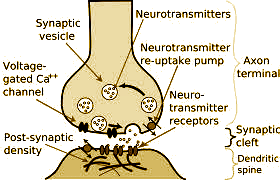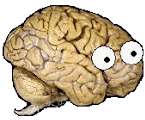
In the Neuroanatomy I took in the 1960s, we learned the tracts of the peripheral nerves, the spinal cord, the cranial nerves, the motor/sensory systems. It was like the wiring diagrams of my stero-building, ham radio days and I took to it like a duck to water. It was aimed at clinical neurology and grand fun. There was lots of other stuff in the brain with mysterious structure or not, and it got phrases like "thought to be involved with emotion" [but it was never on the tests]. Most of the neurophysiology and talk about neurotransmitters had to do with peripheral nerves and pharmacologic agents  [like poisons or blood pressure pills]. If we talked about neurotransmitters [or much of anything else] in the grey-matter, I don’t recall it. That chatter came ten years later in psychiatry, where no drug lecture was complete without what I call the "NIH memorial nerve ending" slide, recycling neurotransmitters of various ilks [later, I had such a slide of my very own].
[like poisons or blood pressure pills]. If we talked about neurotransmitters [or much of anything else] in the grey-matter, I don’t recall it. That chatter came ten years later in psychiatry, where no drug lecture was complete without what I call the "NIH memorial nerve ending" slide, recycling neurotransmitters of various ilks [later, I had such a slide of my very own].
DiscoverBy NeuroskepticSeptember 16, 2014This is the abstract for one of the two talks that I gave last week in Búzios, Brazil for the SBNeC conference: “Why Is It So Hard To Think About The Brain?”…
Today, we are thinking – and talking – about the brain more than ever before. It is widely said that neuroscience has much to teach psychiatry, cognitive science, economics, and others. Practical applications of brain science are proposed in the fields of politics, law enforcement and education. The brain is everywhere. This “Neuro Turn” has, however, not always been accompanied by a critical attitude. We ought to be skeptical of any claims regarding the brain because it remains a mystery – we fundamentally do not understand how it works. Yet much neuro-discourse seems to make the assumption that the brain is almost a solved problem already.
For example, media stories about neuroscience commonly contain simplistic misunderstandings – such as the tendency to over-interpret neural activation patterns as practical guides to human behavior. For instance, recently we have heard claims that because fMRI finds differences in the brain activity of some violent offenders, this means that their criminal tendencies are innate and unchangeable – with clear implications for rehabilitation. Neuroscientists are well aware of the faults in lay discourse about the brain – and are increasingly challenging them e.g. on social media. Unfortunately, the same misunderstandings also exist within neuroscience itself. For example, I argue, much of cognitive neuroscience is actually based on [or, only makes sense given the assumption that] the popular misunderstanding that brain activity has a psychological ‘meaning’.
In fact, we just do not know what a given difference in brain activity means, in the vast majority of cases. Thus, many research studies based on finding differences in fMRI activity maps across groups or across conditions, are not really helping us to understand the brain at all – but only providing us with a canvas to project our misunderstandings onto it. Why do these errors arise? I see the origin of these misunderstandings as being a fundamental difficulty that we have in thinking about “the brain”. We are misled by an implicit mind-brain dualism that leads us astray. The problem is not so much that is difficult to find answers about the brain, but rather that it is easy to ask the wrong questions.
What can neuroscientists do? There are solutions. Neuroscience should be based on clear, falsifiable hypotheses that seek to explain, rather than merely describe, neural and behavioral phenomena. The process of framing testable hypotheses helps us to escape from the misunderstandings. Much of neuroscience already does this, but not enough. As for the public and the media, it is important to remember that misunderstandings of neuroscience can have serious consequences, both directly and indirectly. Generally these errors consist in seeing brain science as more certain than it is, and giving it more authority than it should do in real life scenarios. This lends undeserved power and influence to ideas [e.g. political ideas] that wouldn’t otherwise seem convincing. Public discourse moves this away from rationality towards the appearance of rationality.
In conclusion, both neuroscientists and the public are subject to the same misunderstandings when trying to think about the brain. Neuroscience can advance when it is based more on formal hypothesis testing and less on intuition and interpretation. But the latter approach is common. And in the public sphere it can be dangerous.
 At this point, I could go off on a diatribe about the difference between the Dogmatists and the Skeptics in ancient Greece. In fact, maybe I’ll do just do that. I suppose if you have a favorite Greek philosopher, you can talk about him more than once. So I’ll borrow from a short former accounting for my diatribe·let:
At this point, I could go off on a diatribe about the difference between the Dogmatists and the Skeptics in ancient Greece. In fact, maybe I’ll do just do that. I suppose if you have a favorite Greek philosopher, you can talk about him more than once. So I’ll borrow from a short former accounting for my diatribe·let: Pyrrho [Πuρρων, c. 360 BC – c. 270 BC]:
Pyrrho [Πuρρων, c. 360 BC – c. 270 BC]:Pyrrho was from Elis, a suburb of Athens. He started life as a painter, but gravitated to Philosophy. He became one of the Philosophers that traveled with Alexander the Great on his campaigns of conquest and he was influenced by the Philosophers in the East that he met on those travels. When he returned to Greece, the dominant school of Philosophy was Dogmatism. We know a jaded version of Dogmatism, largely from the excesses of the Catholic Church centuries later. At the time of Pyrrho, Dogmatism was something lofty, like the "search for absolute truth." Pyrrho taught that there was no absolute truth, and his teachings became known as Skepticism. What we know of Pyrrho outside later writings about his philosophy are stories that we know aren’t true. They’re the jokes the Dogmatists made about him – parodies of his indecisiveness. They told the story that Pyrrho was walking down the road and saw a man fall face down in the mud. While Pyrrho pondered, the man died from asphyxiation. Or a story that his students followed him everywhere to make sure that he decided to eat [those old Greeks weren’t so great with jokes]. Since there were no absolute truths, Pyrrho taught that we had to accept relative truth, always maintaining a questioning attitude, vigilant for things that might cause us to revise our former approximations. We might call it healthy skepticism these days, and it’s the essence of the scientific method.
-
We ought to be skeptical of any claims regarding the brain because it remains a mystery – we fundamentally do not understand how it works.
-
… media stories about neuroscience commonly contain simplistic misunderstandings – such as the tendency to over-interpret neural activation patterns as practical guides to human behavior.
-
… much of cognitive neuroscience is actually based on [or, only makes sense given the assumption that] the popular misunderstanding that brain activity has a psychological ‘meaning’.
-
… many research studies based on finding differences in fMRI activity maps across groups or across conditions, are not really helping us to understand the brain at all – but only providing us with a canvas to project our misunderstandings onto it.
-
… misunderstandings of neuroscience can have serious consequences, both directly and indirectly. Generally these errors consist in seeing brain science as more certain than it is, and giving it more authority than it should do in real life scenarios.
“The Old False Dichotomy Problem
We all understand that a human organism requires a central nervous system to operate effectively, and we understand that the brain is part of the central nervous system that is of relevance to understanding behavior. But we do not all agree on the exact relationship between brain and development…” for more discussing this issue from a monistic, functional contextual (aka behavior analytic) perspective, see http://www.psychologytoday.com/blog/iq-boot-camp/201408/what-s-the-brain-got-do-brain-training
Check out this excellent new book by the philosopher/psychologist, Peter Zachar, A Metaphysics of Psychopathology. It is about diagnosis but takes a broad view of philosophical concepts relevant to psychiatry. He is a very good writer and this book has value for people of varying levels of philosophical training.
That’s fascinating, Dr. Steingard, thank you. The liberal arts are being woefully neglected in our hour of need. I have to finish the last book I bought, before ordering this one, but have just learned some concepts that help me explore questions I have with less clunk and conclusion while reading reviews of this book.
What is “real”? Indeed.
I meant confusion, but lessening “conclusion” applies, as well. It’s so much more fun and productive, I think, to widen the lens and to ask better questions than it is to invest too much energy in a limited and fossilized view.
As a person who has been an ad hoc reviewer for the NIMH, I would like to say that the standards for reviewing and evaluating grants is very high. The expertise of the reviewers is also excellent (reflecting more on my peers than on myself). These men and women do an excellent job (in my opinion) of making sure that grants are based on solid science and can deliver meaningful results. What we do with these findings after they are reported is a whole different problem — and a large one.
On another topic, I think that Oliver Sacks is a good role model for clinicians who are trying to use basic neuroscience to inform clinical practice. He has an excellent grasp of basic neuroscience and neurology but does not limit himself to abstract applications of his knowledge. He carefully examines how neurological conditions affect life as lived. I have often thought of him as “the psychiatrist of neurologists.”
One last thought. We have spent so much time trying to hammer home the materialist position that “the mind is the product of brain function.” Now we are supposed to tell people that it is a misunderstanding to say that “brain activity has a psychological meaning”? It sounds like we need to get our act together if we want to have a consistent message.